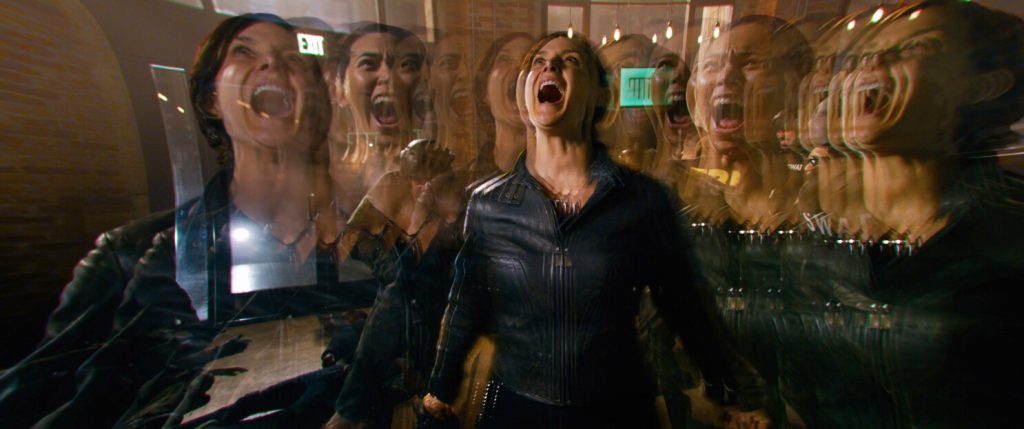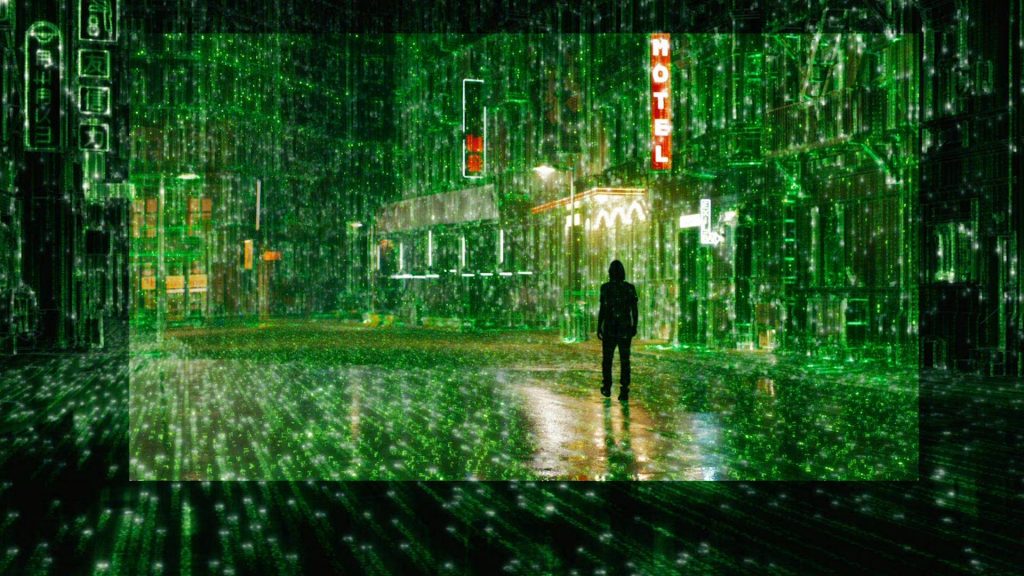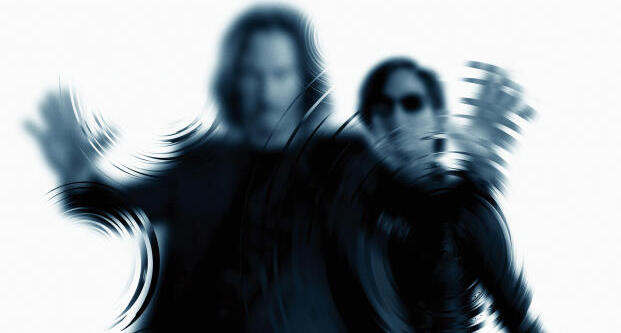A reflection. An image all too familiar from countless bouts of repetition, inscribed into the mind. The shadows, the sheen, the sounds-they’re all the same. Only something’s a little off: it’s inverted. This reflection lingers for a moment, then dissipates as it is disrupted by agents of control.
The opening frame of The Matrix Resurrections is a rather mundane one, but it acts as a summation of Lana Wachowski’s thesis. The shot Is directly lifted from the very first entry in what is now The Matrix quadrilogy, and it’s evocative of a sequence that nigh-everyone and anyone with a passing interest in cinema has seen: Carrie-Anne Moss as Trinity, performing acrobatic feats that defy the laws of reality. It’s something that exists as a vague collection of shapes and sounds in most people’s minds, returning to the surface of consciousness when someone mentions The Matrix in conversation. It’s something that we’d have trouble mistaking for anything else, which is why it’s so effective as, essentially, a lure. We anticipate a recreation of the past, an attempt at replicating what made The Matrix a global phenomenon, and a shying away from what made the sequels (Reloaded and Revolutions) so divisive. In essence, a celebration of nostalgia is what would be the most logical or likely pattern for a fourth Matrix film, releasing 18 years after what had long seemed the definitive conclusion to the Wachowski Sisters’ sci-fi vision. There have been many other films that have sought to do just that; take Space Jam: Legacy, a sequel to the glorified Looney Toons toy advert that was the first Space Jam. Releasing the same year as Resurrections, it maximizes the full potential of Warner Bros’ IP vault by squeezing the life out of as many properties as it can, from Casablanca to The Matrix itself. It isn’t the first of its kind to shamelessly indulge in jangling keychains in front of an audience that may as well be children; The Force Awakens, Jurassic World and Halloween (2018) are all similarly embarrassing attempts at recapturing the half-remembered dreams of childhood whilst avoiding the seemingly insurmountable obstacle of bearing any authorial fingerprints. The Matrix is a story that seems vulnerable enough prey for craven marketing heads to wrap their claws around, considering how many of its moments are likely to induce knowing grins and catchphrase repetitions from audiences.

That, however, would require the separation of art from the artist, which Resurrections couldn’t be further from. Beyond being a Matrix sequel, this is Lana Wachowski’s story. It is, among other things, an artist’s fierce attempt to reclaim her life’s work even if that means burning innumerable bridges. The Matrix, for all its potency as a liberatory parable, has been filtered through the lens of culture so many times that it’s become fragmented into, as Baudrillard would call it, images divorced from the original. A rather aggravating montage set to White Rabbit, where corporate executives debate what The Matrix “is” comes to mind; it’s maddening in its mundanity, and yet, far from feeling grating in its metatextuality, it’s painful. Corporate obsession with an endless production line of sequels and remakes is far from a novel concept. In particular, the late, great Wes Craven’s Scream 4 and New Nightmare are both metatextual sequels that recontextualise the events of preceding films as just that — works of fiction, from which the inextricable pain of both the creator and the characters is divorced.
What makes Lana Wachowski’s self-referential work so compelling despite the oversaturation of such art today is its unflinching resolve in examining the artist’s own struggles, such that it often seems as if her characters’ comments are her own. By converting the original trilogy into neatly packaged blocks of “content” in the world of Resurrections, Wachowski effectively abandons any notion of subtlety, instead choosing to approach her relationship with a deeply personal work of art through the lens of old friends: Neo and Trinity (or, as they are termed by the engine of the Matrix, Tom Anderson and Tiffany). The shot compositions of the first segment of the film, set within the Matrix itself, mirror this concern with literalization. As opposed to Bill Pope’s visual dynamism in the original trilogy, which conveyed danger around every corner and a superhuman sense of movement, John Toll’s approach to the interactions between Neo and Trinity is remarkably mundane. In these scenes, the camera never wavers, always focusing on Reeves’ and Moss’ faces. There are no disruptions to suggest that reality may not be as it seems. In doing this, the film foregoes the simulation’s defining element of paranoia within The Matrix and The Animatrix, choosing instead to centre us inside an emotional landscape rather than of a structural one. The delightfully inscrutable jargon and philosophical parables that characterized communication in the trilogy persists — perhaps to an even greater extent — but it’s here that Wachowski’s commitment to sweeping emotion is most evident. Reeves and Moss, two immensely talented performers, have remarkably few interactions, yet in each one, the weight of decades gone by as both performers and slaves of the Matrix can be felt deeply, almost painfully so. The lack of formal rigidity here renders Reeves and Moss the film’s emotional centre; and why shouldn’t it? After all, Neo’s realisation of his destiny as The One (not to mention being resurrected after being shot through the heart multiple times) is set into motion by a kiss of life. In Reloaded, the Wachowski Sisters’ belief that love can transcend every constraint is taken to its furthest when Neo resurrects Trinity by quite literally pumping her heart back to life.

And yet, despite its earnestness in envisioning a world where love transgresses material boundaries, Resurrections is the furthest it could be from a nostalgia trip. As much of a sequel it may be, it acknowledges the impossibility of returning to the past as it once existed, no matter how much we may want to. Reloaded’s concerns with the pace of revolution and the individual within it, similarly, are mirrored, but as opposed to this existing within a space where there is impetus for conflict, it wrestles with the often cloudier implications of its aftermath: what happens when the threat around which your existence revolves is no longer a threat? By framing Neo as just another cog in a machine, Resurrections places the Campbellian journey into the stark light of day. Our heroes are shells of themselves, no longer able to occupy the enormity that they once did. This is reflected in Neo’s own internal conflict over his self-image, a transmogrification of the trans subtext within the original into the text itself which is evidently deeply personal Wachowski. These reflections are often literal: there are occasional flashes in Neo’s reflection of a greying, balding man.
“The world doesn’t end when you do”
Beyond simply recontextualization of these characters, Resurrections makes a deliberate attempt to distinguish itself from its predecessors in ways that were bound to be more alienating than not. The carefully-choreographed dynamism of the martial arts sequences in the first 3 films (led by Yuen Woo-ping) is replaced with noticeably less fluid brawls. Whereas those sequences flowed through the narrative as central components without missing a beat, here the action interrupts — rather than propels — the film’s momentum. Instead of clarity, they provide obfuscation through increasingly frenetic editing. To assume that this isn’t intentional would be to overlook every other aspect of the film that tries to differentiate itself from the original trilogy — after all, these characters are no longer the same. 60 years have passed since Revolutions, moulding Neo into a fossil, not to mention the evolution the Matrix itself has undergone. The stark, noncommittal architecture of the nameless city where Neo awoke from the simulation was defined by its indefinite nature as a blank slate upon which authority imprinted structure. Here, the Matrix acquires a consciousness of its own, mirroring 2021 in a viciously satirical version of San Francisco, complete with insufferable tech developers and boutique coffee shops. Even the colour grading has evolved, rendering it more vivid than the green-tinted mass of featureless skyscrapers we saw before. As a result, it’s evolved to adapt to those that reside within it, making it even more treacherous for those who awaken from it; something that’s reflected in the irregular turbulence of the action sequences. As opposed to depicting superhuman beings defying the rules of spacetime, Resurrections renders them vulnerable in its depiction of action that is so often out of control that it overwhelms both the spectator and the characters. Take the one and only clash between Neo and the reincarnated Smith: there are no acrobatics, no dodging bullets and no manipulation of spacetime. Instead, the camera cuts upon each impact to another, never slowing down to allow us to observe what is ostensibly a confrontation 60 years in the making. At every opportunity, the frame is abstracted into a blur of colours and extreme contrast, reflecting a heightened dramatism (which, according to Wachowski, was a result of Resurrections’ primary visual reference being Caravaggio), not unlike the Wachowski Sisters’ Speed Racer. The precise colourimetry of the first iteration (both in terms of the installment and the fictional simulation) is replaced by a certain naturalism, but one which is no less precisely calculated because it exists to provide the illusion of freedom. This lack of control over form is reflective not just of Neo’s state of internal turmoil, but of the director’s, too. Groff deliberates upon the personal grounding of Wachowski’s evolution as a filmmaker:
“”She [Lana Wachowski] was explaining to us how, in her earlier work, she would storyboard things like they were comic books almost, and create exact frames of what she wanted as her way of literally controlling her narrative, because there was so much out of control inside of her. Then when she embraced her identity, this articulated itself in her work and opened her up to the idea of capturing the things that can’t be controlled.”

Rather than resisting change through barriers of the familiar, then, Resurrections embraces it, yet at the same time, never disregards the sweat and tears it took to arrive at the culmination of this liberatory arc. Neo may no longer be the focal centre of a revolution, but his contributions to the advancement of a resistance are recognised without any hint of the irony or snark that characterizes recognition of legacy in other, less sincere iterations of drawn-out franchises. The extensive utilization of fluid metal and warm lighting in Io (Zion’s successor) is one of many visual indicators that mark the irreversible change that this revolution has undergone, rendering the humans of Resurrections no longer perpetual participants in a forever war, but instead inhabitants of a peacetime state. The revolutionary characteristics seem to have been subsumed by a bourgeois consciousness that no longer seeks to place itself at risk in order to further the cause of a revolution. In many ways, the thematic underpinnings of this transition reflect Resurrections’ own uneasiness as a sequel. It condemns the extension of stories beyond their authorial conclusions by placing its two focal characters in a state of torment made possible by the need to make a Matrix sequel, which seems contradictory and nigh-hypocritical. What distinguishes this from a mere appendix, however, is the fact that this it arises from a position not unlike that of Neo and Trinity; one of grief, and the need to reshape a work of fiction as real to the author as the Matrix is to these characters, which Lana Wachowski herself articulated in an interview preceding Resurrections’ release:
“I couldn’t have my mom and dad… yet suddenly I had Neo and Trinity, arguably the two most important characters in my life,” she continued. “It was immediately comforting to have these two characters alive again, and it’s super-simple. You can look at it and say: ‘Okay, these two people die, and okay, bring these two people back to life, and oh, doesn’t that feel good?’ Yeah, it did! It’s simple, and this is what art does and this is what stories do. They comfort us and they’re important.”
The Matrix Resurrections out right now:




